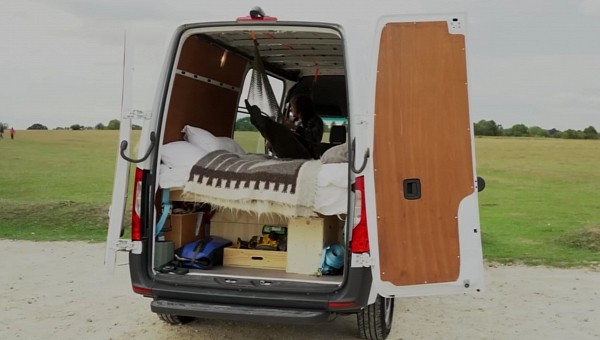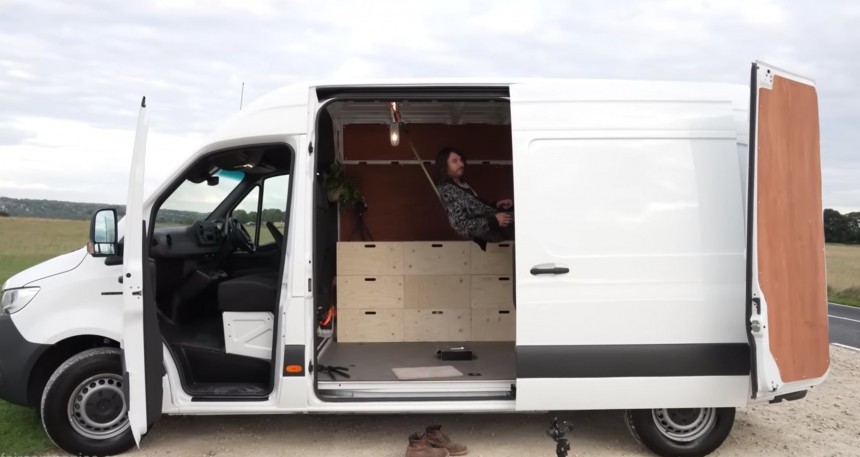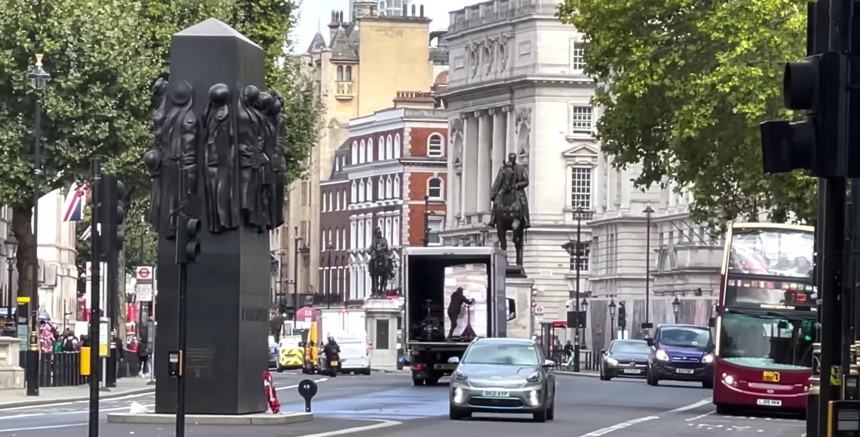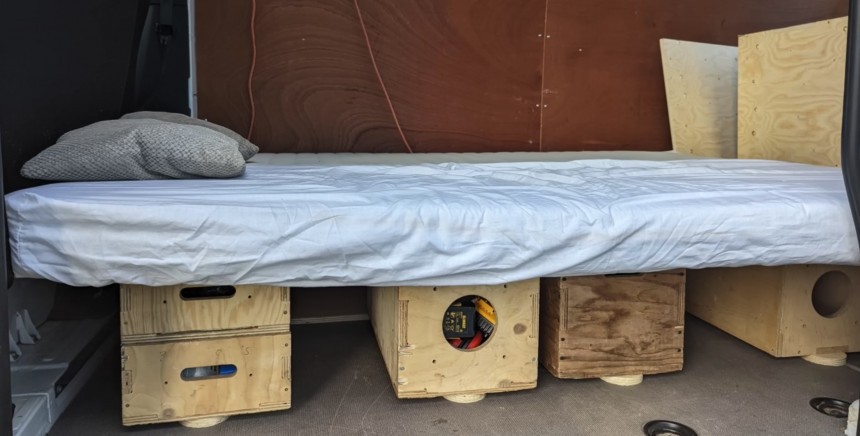With the average median annual income in the United Kingdom ranging between £30,000 ($35,538) and £41,866 ($49,594) and the average house price according to the UK’s Land Registry at £543,100 ($643,358), it’s only normal that people will begin improvising to survive. We are not talking about homelessness, but a trendy new community called the motorhome movement.
Not many people believe in the motorhome movement. Like the tiny house, a motorhome might feel impractical, unconventional, and, more loosely put – why the hell would anyone live in a car for the rest of their lives?.
Living in a motorhome isn’t a foreign concept for many people in the developed world. If anything, RVs (Recreational Vehicles), which also happen to be motorhomes, have been around since 1915. Still, these motorhomes have never been permanent living solutions for people but vessels designed for vacations and short stays.
If you live in a busy city like New York, Los Angeles, San Francisco, or London, the cost of living is relatively high. And depending on your income and stability, you might have gotten to a point where homelessness was patently staring at you in the eyes.
For those fortunate enough to own an automobile, squeezing into your four-seater sedan for the night is a viable option. According to a Homeless Rights Advocacy Project at Seattle University, “Vehicle Residency is one of the fastest growing forms of homelessness in the U.S.”
But here’s the truth. Tiny homes and motorhomes communities are nothing like homelessness. If anything, they are deltas apart. These communities thrive on the notion ‘less means more,’ a foreign statement for individuals who’ve spent their lives dragging the weighty shell of their earthly possessions everywhere they go.
We’ve covered hundreds, if not thousands, of stories on tiny/motorhomes, but none comes close to this. Kirsten Dirksen of Faircompanies got to feature an unusual type of motorhome. If IKEA and LEGO got together, this would be their lovechild.
Nick Newman, the co-founder of U-Build, has brought a new meaning to ‘less means more.’ Due to the nature of his work, which requires him to live a nomad lifestyle, he turned his Mercedes-Benz eSprinter electric van into a peculiar motorhome.
He’s taken the concept of living with less to an entirely new level with his IKEA-style, LEGO-designed motorhome.
So, what makes his Mercedes-Benz eSprinter special? One, it's roomy, two, it's fully electric.
The first generation of the Mercedes-Benz eSprinter was announced in February 2018. It’s a fully electric van based on the third-gen Sprinter. It came with two battery options.
On the lower end of the spectrum, a 41 kWh pack averaging 71.5 miles (115 kilometers). The higher variant with 55-kWh battery levels up to 93 miles (150 kilometers). For this reason only, the first generation never made it to the U.S.
It packs an 84 kW and 221 lb-ft (300 Nm) electric motor. The needle of the speedometer can hit 75 mph (120 kph).
Those living in central London understand the benefits of owning an electric car. For one, you can park anywhere. There’s no congestion charge.
All electric and hydrogen fuel cell cars are exempted from the London Congestion Charge. It’s part of the city’s Cleaner Vehicle Discount (CVD).
Previously, owners of PHEVs with a 20-mile electric-only range and 75g/km of CO2 emissions were exempt, but now, they have to pay.
Also, parking in the congestion zone is free from 11 pm into the morning, another bonus for Newman when he needs to charge the van while staying overnight.
“It’s quiet. It’s better for the environment. Also, the whole battery, I can use it for heating and that kind of thing.” Newman revealed.
Newman didn’t always live in an electric van. Initially, he lived in a subdivided warehouse unit for £800 ($947) a month. He had the van that, according to him, was mostly empty. That’s where the lightbulb moment hit.
Using the same modular construction system his U-Build company subscribes to, he used the flat-pack box system to turn his Mercedes eSprinter van into a full-time home.
“I was like, I want to have this in my own life, and I couldn’t afford to build a whole house, but I could definitely afford to fill my van with some,” he said.
According to Newman, his company’s U-Build construction method (like IKEA or LEGO) is simple enough to build and assemble structures using only a mullet and a screwdriver.
The boxes click up together to make the base of his bed. He uses a block board on top, equivalent to a double-size bed. The boxes underneath also double up as storage spaces where he stores his belongings.
The U-Build boxes can also be merged to form a kitchen unit on one side of the van.
If you’ve lived in an RV or camper van, you understand the main challenge is keeping things in place while the eSprinter moves. Since Newman’s U-Build boxes aren’t screwed to the floor. The likelihood of boxes scampering all over was high.
He improvised the van’s load straps to hold onto the bolted-together U-build boxes to keep everything in place while the vehicle was in motion.
He also needed to remove the metal bulkhead that separates the driver cabin from the cargo area. Initially, locking the van from the cargo area while it was operational (drive mode) was impossible.
Also, to keep the van running, he puts a container on the seat, a hack designed to confuse the van system that someone is in the driver seat. This prevents the van from automatically shutting down.
Newman attributes the inspiration behind his company and motorhome build from his childhood playing with LEGOs. “Now, I’ve realized that basically, I’m just doing exactly the same thing again,” he added.
Newman admits his motorhome is still a work in progress. We can’t wait to see what it’ll look like two years into his residency. In the meantime, we recommend catching a glimpse of his ingenuity in the video below.
Living in a motorhome isn’t a foreign concept for many people in the developed world. If anything, RVs (Recreational Vehicles), which also happen to be motorhomes, have been around since 1915. Still, these motorhomes have never been permanent living solutions for people but vessels designed for vacations and short stays.
If you live in a busy city like New York, Los Angeles, San Francisco, or London, the cost of living is relatively high. And depending on your income and stability, you might have gotten to a point where homelessness was patently staring at you in the eyes.
For those fortunate enough to own an automobile, squeezing into your four-seater sedan for the night is a viable option. According to a Homeless Rights Advocacy Project at Seattle University, “Vehicle Residency is one of the fastest growing forms of homelessness in the U.S.”
IKEA and LEGO lovechild
We’ve covered hundreds, if not thousands, of stories on tiny/motorhomes, but none comes close to this. Kirsten Dirksen of Faircompanies got to feature an unusual type of motorhome. If IKEA and LEGO got together, this would be their lovechild.
Nick Newman, the co-founder of U-Build, has brought a new meaning to ‘less means more.’ Due to the nature of his work, which requires him to live a nomad lifestyle, he turned his Mercedes-Benz eSprinter electric van into a peculiar motorhome.
He’s taken the concept of living with less to an entirely new level with his IKEA-style, LEGO-designed motorhome.
So, what makes his Mercedes-Benz eSprinter special? One, it's roomy, two, it's fully electric.
The first generation of the Mercedes-Benz eSprinter was announced in February 2018. It’s a fully electric van based on the third-gen Sprinter. It came with two battery options.
On the lower end of the spectrum, a 41 kWh pack averaging 71.5 miles (115 kilometers). The higher variant with 55-kWh battery levels up to 93 miles (150 kilometers). For this reason only, the first generation never made it to the U.S.
It packs an 84 kW and 221 lb-ft (300 Nm) electric motor. The needle of the speedometer can hit 75 mph (120 kph).
His Mercedes-Benz eSprinter is London Congestion Charge exempt
All electric and hydrogen fuel cell cars are exempted from the London Congestion Charge. It’s part of the city’s Cleaner Vehicle Discount (CVD).
Previously, owners of PHEVs with a 20-mile electric-only range and 75g/km of CO2 emissions were exempt, but now, they have to pay.
Also, parking in the congestion zone is free from 11 pm into the morning, another bonus for Newman when he needs to charge the van while staying overnight.
“It’s quiet. It’s better for the environment. Also, the whole battery, I can use it for heating and that kind of thing.” Newman revealed.
Newman didn’t always live in an electric van. Initially, he lived in a subdivided warehouse unit for £800 ($947) a month. He had the van that, according to him, was mostly empty. That’s where the lightbulb moment hit.
Using the same modular construction system his U-Build company subscribes to, he used the flat-pack box system to turn his Mercedes eSprinter van into a full-time home.
“I was like, I want to have this in my own life, and I couldn’t afford to build a whole house, but I could definitely afford to fill my van with some,” he said.
U-Build construction method is as easy as LEGOs
The boxes click up together to make the base of his bed. He uses a block board on top, equivalent to a double-size bed. The boxes underneath also double up as storage spaces where he stores his belongings.
The U-Build boxes can also be merged to form a kitchen unit on one side of the van.
If you’ve lived in an RV or camper van, you understand the main challenge is keeping things in place while the eSprinter moves. Since Newman’s U-Build boxes aren’t screwed to the floor. The likelihood of boxes scampering all over was high.
He improvised the van’s load straps to hold onto the bolted-together U-build boxes to keep everything in place while the vehicle was in motion.
He also needed to remove the metal bulkhead that separates the driver cabin from the cargo area. Initially, locking the van from the cargo area while it was operational (drive mode) was impossible.
Also, to keep the van running, he puts a container on the seat, a hack designed to confuse the van system that someone is in the driver seat. This prevents the van from automatically shutting down.
Newman attributes the inspiration behind his company and motorhome build from his childhood playing with LEGOs. “Now, I’ve realized that basically, I’m just doing exactly the same thing again,” he added.
Newman admits his motorhome is still a work in progress. We can’t wait to see what it’ll look like two years into his residency. In the meantime, we recommend catching a glimpse of his ingenuity in the video below.
















